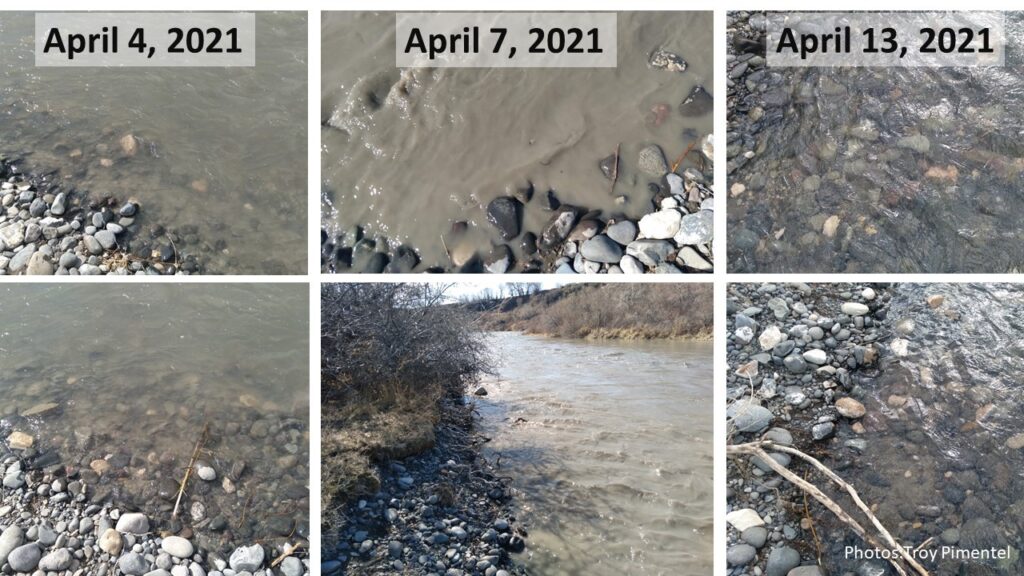
By Kristine Galloway
CHEYENNE – The Shoshone River fishery has improved and is now better-protected thanks to joint
efforts by Wyoming organizations.
The Wyoming Department of Environmental Quality (DEQ) partnered with multiple organizations to
redesign operations at the Willwood Dam in Park County to improve sediment management to better
protect water quality standards and support the downstream fishery.
DEQ, the Willwood Irrigation District (which operates the dam), the Wyoming Game and Fish
Department, the U.S. Geological Survey (USGS), the Powell Clarks Fork Conservation District, the U.S.
Bureau of Reclamation and others began work in 2016 to improve the dam’s operations.
Lindsay Patterson, surface water quality standards supervisor for DEQ, explained that in 2016, the
Willwood Dam operators performed a large maintenance project that resulted in a sediment release.
Patterson explained that sediment had been accumulating behind the dam since the 1980s because of
operating criteria that the dam operators were required to follow. As a result, operations at the dam
sometimes caused sediment releases that were harmful to the fishery. The release in 2016 was not the
first such event.
In 2017, Kevin Frederick, DEQ’s former Water Quality Division administrator, initiated an executive
committee and three working groups to address the problem.
The working groups took on the following tasks:
● Working group 1 – Clean up the sediment, trash and debris that were released from the dam
(completed in 2017)
● Working group 2 – Find a way to operate the dam that would allow the sediment to be released
while still protecting all downstream aquatic life
● Working group 3 – Identify where the sediment behind the dam is coming from within the
watershed and determine if there is a way to reduce the sediment accumulation
Working group 2 was successful in finding ways to operate the dam that protect the aquatic life.
Patterson said, “One of the first things we did as work group 2 was to revise the operating
recommendations for the dam.”
Jason Alexander, surface water studies chief with the USGS Wyoming-Montana Science Center, said
“Collective scrutiny of the data and results helped build trust between members of the group, and that
trust resulted in the design of experiments with the dam to see if it could be operated to benefit the
fishery while maintaining the original purpose of the dam.”
He added that the work allowed the team to design the first controlled sediment release and flushing
flow on the Shoshone River.
Patterson said that the working group updated the operating recommendations and now the next step
is for research performed by Ashleigh Pilkerton to inform additional revisions.
Pilkerton is a PhD student with the Wyoming Cooperative Fish and Wildlife Research Unit in the
University of Wyoming’s Department of Zoology and Physiology.
She is conducting two intensive research projects – funded by the Wyoming Water Research Program
and the USGS – to better understand how the movement of sediment affects downstream fisheries.
She said, “(The research) equips managers and stakeholders with site-specific knowledge to best protect
and maintain downstream fisheries and other aquatic life in the Shoshone River, with broad applications
to dam sediment management worldwide.”
The dam is essential to the district for impounding the Shoshone River, thereby raising the water level in
the Willwood Canal to be distributed to users, such as farmers.
Travis Moger, manager of the Willwood Irrigation District, performed the dam operations for most of
the data collection efforts throughout the project. He said the dam is 100 years old but still performs
essential functions, and the reduction of sediment will extend the life of the dam.
Moger explained that the Irrigation District provides water from the Shoshone River to 11,595 acres.
Ann Trosper, manager of the Powell Clarks Fork Conservation District, said that the health of the
Shoshone River is important because the river provides water not only to the Willwood Irrigation District
but to various other communities, including Cody and Powell. Excess sediment in the river could
adversely affect the water provided to those communities and other irrigation areas.
Patterson explained that the working group’s goal is to have the amount of sediment coming into the
dam mirror the amount they can release.
“Ideally, we want them to mobilize what’s coming in on an annual basis so that they are not
accumulating sediment behind the dam,” she said.
Now that sediment releases are more controlled, dam operators can ensure that it isn’t deposited in
areas that are important to the trout fishery.
Jason Burckhardt, fisheries biologist for the Wyoming Game and Fish Department, did a lot of sampling
at the Shoshone River, including downstream of the Willwood Dam.
“Our role is to provide angling opportunities for those who want to fish down there. So, we have that
recreational component, but we also have a role in managing aquatic resources and those aquatic
animals,” he said.
Burckhardt explained that the Shoshone River is classified as a blue-ribbon stream/river, which means it
ranks in the top three percent of all trout fisheries in the state.
He added, “You have a lot of competing interests and fishing was just one of those. We’re seeing that
there is a possibility of having a sustainable excellent trout fishery below Willwood Dam while providing
the Irrigation District with the water they need.”
Patterson said this project is unique because there are so many partners that have all come together
with different needs and have successfully worked together to improve the dam and fishery while
supporting diverse interests. She said the various viewpoints are a strength of the project.
Patterson added, “This project points out the fact that, in some circumstances, a strict application of the
Water Quality Standards may not lend itself to best protecting the resource. It helps to think a little
differently about the standards and how their ultimate goal is to protect the water source. In this case,
we’re protecting the fishery.”
